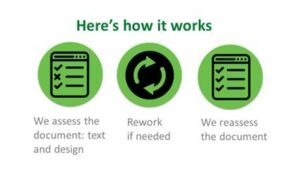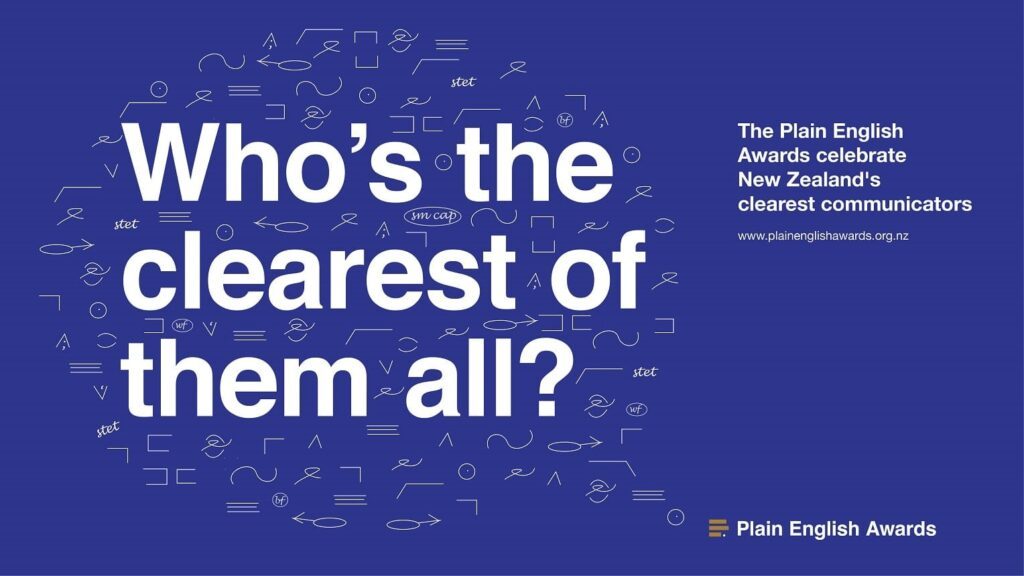WriteMark
Plain Language Standard
Stand out from the crowd in three easy steps

Not a pair — 3 steps to the WriteMark: Image by Shumilov Ludmilla. Unsplash license.
You’ve got sparkling content, you want to show customers that you care about their needs, and you’re ready to wear your heart on your sleeve (or the WriteMark® logo on your document).
What do you do?
We’ve made the process for getting the WriteMark® straightforward and transparent — as easy as 1-2-3.

First things first
Get in touch and let us know what sort of content you’d like us to assess, and whether it’s one document or webpage, or part of something bigger. We’ll give you a price and a timeframe.
Step 1: Assess the document
Once we have your document, our assessors get to work holding it up against the 28 elements of the WriteMark® Standard. These elements fall into 5 categories.
- Structure
- Content
- Language
- Grammar, proofreading, and style
- Layout and overall presentation
If you’re applying for the WriteMark® Plus, we’ll also look at how you tested your content with readers and any changes you made based on their feedback.

Give your customers the clarity they deserve. Image by David Travis. Unsplash license.
Step 2: Rework if needed
We’ll give you a written assessment. You’ll easily see where your document or digital content has met an element of the WriteMark® Standard, and where it might need more work.
If something doesn’t meet the Standard straight away, we’ll explain why and suggest how to fix it. We’ll also give you an idea of the scale of the problem, and explain why it matters.
You can then make the changes, or ask us to.
Here’s an example of what we might suggest to help you improve your sentences to meet the Standard:
We suggest you rewrite some long sentences to make them shorter, clearer, and easier for readers to scan. For example:
Instead of
If any claim under this or any other policy with us is supported by any incorrect, incomplete, or fraudulent information or statement, then your claim is not payable and this policy will be automatically terminated from the date that the information or statement was supplied to us, or the statement or fraudulent claim was made to us. We may also terminate any other policy you have with us at the same time.
(Two sentences: 57 + 15 words)
You could write
If you claim under this policy and give us any incorrect, incomplete, or fraudulent information or statements, we may:
- refuse your claim
- end your policy from the date you supplied misleading information or statements
- end any other policy you have with us.
(One sentence broken into bullet points: 41 words)
Step 3: Reassess the document
We’ll look at your document again, and either award it the WriteMark® or let you know where you still need to make changes.
Your trusted advisors
You can ask us questions at any stage. Our team of assessors is here to help — we understand that it’s not always straightforward getting agreement from everyone involved in bringing a piece of writing to life. We’ve learned successful ways to communicate complex terms that at first seem intractable.
Your words are in good hands
Our assessment criteria are based on reader testing, cognitive fluency research, national and international standards, and many years of experience. We work on behalf of readers and in partnership with you.
Wear your heart with pride
After Step 3, you’re ready to tell the world that your document meets the highest standard of clarity and customer care.
Achieving and displaying the WriteMark®:
- shows you value clear communication
- tells your customers you care about their needs
- builds goodwill and loyalty
- sets you apart from your competitors
- saves you money.
Towards excellence
If you make changes to your content after receiving the WriteMark®, you’ll need to check back with us to make sure it still meets the WriteMark® Standard. Once you’re in the swing of hitting the clarity standard every time, we can show you even more ways to polish your content to perfection.
Anne-Marie Chisnall September 16th, 2019
Posted In: The WriteMark
Clarity is the heart of the matter

Long roads can read to beautiful destinations.
Australia’s Budget Direct Insurance is always looking for ways to set itself apart from the competition. In 2017 the company identified the opportunity to improve the overall customer experience, by creating the easiest-to-understand Home and Contents Product Disclosure Statement (PDS) in the marketplace.
After a highly worthwhile journey — that took a little longer than expected — the new PDS was published this week. And it became the world’s first document carrying the heart with a tick — not just the prestigious WriteMark®, but the ultimate WriteMark® Plus.
What is the WriteMark® Plus?
When a document or website holds the WriteMark®, customers know that the writing meets a very high standard of clarity. Experts have evaluated the writing against rigorous criteria, emphasising the needs of the audience. The WriteMark® Plus includes testing the document with the intended audience.
Each journey begins with a single step
By mid-2018, Budget Direct had spent 12 months gathering information about the challenge ahead:
- analysing PDSs available to consumers
- running workshops with the business
- analysing their current document
- considering potential regulatory reforms.
Struggling to find good examples to follow, they extended their search. They saw that Tower in New Zealand had won an award in the Plain Language Awards. They phoned us to ask who did our type of work in Australia. ‘We do,’ we told them. Two of our consultants travelled to Brisbane to talk about Budget Direct’s vision for the document and how we could help.
The road is long, and good things take time
The project involved a lot more than a simple rewrite. For the change to be permanent, Write and the project team at Budget Direct needed to bring the rest of the organisation along with them.
Legal and compliance teams had to be satisfied that the changes reduced risk rather than introducing it. Systems and processes had to change with the new content. Every piece of content needed to be tracked through each stage of writing, review, editing, and testing.
Fortunately, Budget Direct took the time they needed to deliver the best result.
Difficult roads often lead to beautiful destinations
After lots of hard work, the Budget Direct PDS for the Home and Contents Policy is at last ready to take its place in the market. It’s now easy to read, understand, and act on. Insurance customers have endorsed the change. And the policy carries the WriteMark® Plus to confirm all that care has paid off.
Budget Direct told us at the start of the project that success is when customers say, ‘Wow! I didn’t know insurance could be this easy.’
‘Write made it easy. Customers now have a quality PDS that’s easy to read and understand. Our consultants love it because they can now have more informative conversations and deliver greater value to our customers.’
That was Write’s goal. That’s why we’re proud to have given Budget Direct a document with heart.
Check out Gusto, the wonderful designers who worked on the document.
Explore the design in Gusto’s portfolio of recent work
And you can view the whole document at the WriteMark® holders page.
Anne-Marie Chisnall September 13th, 2019
Posted In: WriteMark Plus
Tags: Budget Direct, clear language, clear thinking, clear writing, improved writing, industry standards, plain language, power of plain language, Quality writing, writing for the public
Win–win for writers and readers

Working together to bring clarity out of confusion. Image by Adi Goldstein. Unsplash licence.
What’s better than a ‘force for good’ advancing the quality of communication for everyday New Zealanders?
Two forces for good.
WriteMark® is the founding sponsor of New Zealand’s Plain English Awards — a celebration of clear communication and a public pat on the back for plain English champions.

Recognising the highest-quality communication
For 14 years WriteMark® has backed the Plain English Awards Trust to fund, organise, promote, host, and celebrate the annual Awards. The Awards recognise commitment to clear language on all scales — whether it’s across an organisation as a whole or down to a sentence that shines.
But it’s not just about wiping out the waffle. It’s about everyone’s right to take part in society. Information needs to be easy to read, understand, and act on — for all of us.
Making a real difference
The effect of WriteMark® joining forces with the Plain English Awards has been profound. Feedback has shown that the Awards:
- are highly valued by entrants, winners, judges, and sponsors
- offer a benchmark for organisations to assess their own performance
- have resulted in positive, meaningful change in communications for all New Zealanders
- can transform organisations — the process leading to success in the Awards has created widespread change for some organisations.
Working together for all
A piece of communication displaying the WriteMark®, or that has won a Plain English Award, shows the world that writers have thought carefully about their readers. And it shows readers that they can expect to easily understand and act on the information in front of them.
Now that’s a winning combination.
Anne-Marie Chisnall September 11th, 2019
Posted In: Plain English, Plain English Awards, WriteMark Holders
Tags: clear language, clear thinking, clear writing, improved writing, industry standards, plain language, power of plain language, Quality writing, writing for the public
Heart from the start — the story of the WriteMark®

If you’ve earned the WriteMark, you’re in good company. Image by Jon Tyson. Unsplash license.
It’s no coincidence that the WriteMark® logo is shaped like a heart. From a flicker of frustration in the late 90s to ‘the Oscars of plain language’ today, the notion of heart has pulsed through.
Heart in the sense of care and commitment to customers, and heart in the sense of backbone and determination.
In 1999, after almost 10 years helping people write better business documents, Write Group’s Lynda Harris felt a growing discontent.
‘I felt that we weren’t yet making enough of a difference.’
More talk than walk
With a few notable exceptions, we were still being asked to train groups of 12–14, rather than whole organisations. This meant that the effect of the training was often quickly undone by well-meaning managers. The pull of business-as-usual was strong.
‘A lot of our clients openly said they wrote in plain English, or had set that as an expectation, but in the thousands of business documents that passed through our hands each year, we saw very little in practice.’
A twin solution needed
It was crucial to get everyone to truly see what clear writing looked like, and to understand the profound effect it had on relationships and revenue.
Two things were needed: a clear standard of plain language and an easy way to show when something had met that standard.

A home-grown twin approach. Image by Jørgen Håland. Unsplash licence.
Crystal clear — but not over here
In 2000, Write began working with the UK-based Plain English Campaign and its badge of clarity — the Crystal Mark. The Crystal Mark showcased organisations that really cared about communicating clearly and openly. And it introduced both a quality standard and a way of recognising you’d met it.
But the UK-priced Crystal Mark proved too expensive for New Zealand businesses and didn’t feel relevant for our market. After 2 years, Lynda knew she had to try again with something just right for New Zealand.
WriteMark® sets the New Zealand standard
It took time, courage, and commitment, but by mid-2004 the idea for New Zealand’s homegrown WriteMark® had started coming to life.
‘We were a small, highly skilled company, passionate and dedicated to spreading the plain language message. If we were going to launch our own mark, it had to work.
‘We held focus groups in the public and private sectors and did extensive research into international plain language organisations. We set and refined the elements that make up the WriteMark® Standard, and set up a training and moderation process for assessors.
‘We based our fees as low as we could to encourage all New Zealand organisations to invest in plain English. We offered free WriteMark® assessments to organisations that had already advertised a commitment to plain English. They could immediately see the benefits of a standard-based assessment.’

From New Zealand to the world
On 1 March 2005, the WriteMark® launched, and it didn’t take long for businesses and government to take notice.
Over the years WriteMark®’s assessors have checked hundreds of documents against 28 criteria, and helped writers make changes where their documents don’t measure up.
The WriteMark® criteria reflect internationally recognised benchmarks for plain language and clear online communication. They include plain language, usability, suitability for the target audience, and design.
Although grown in New Zealand, the WriteMark® also distinguishes quality documents and websites overseas.
Recent recipients of the WriteMark® say the quality mark is the ultimate achievement for advocates of plain language. It reassures readers that something is clear, expert, and has reliable information that people can follow.
Achieving the WriteMark® shows your genuine care and consideration for customers, with a side effect of saving time and building trust.
User-testing a real plus
Today, holders of the WriteMark® can go even further to show they’re committed to excellent communication with customers. WriteMark® Plus combines an expert assessor view with insights from the people who matter.
A WriteMark® Plus quality mark shows that you’ve also rigorously tested your content on real people in your target audience
Using the power of words for good
For Lynda, it has always been about real people and using the power of words for good.
‘People can communicate their ideas and get the information they need. And ultimately it leads to a fairer, more respectful society.’
A society with heart.
Anne-Marie Chisnall September 10th, 2019
Posted In: Plain language, The WriteMark
Tags: clear language, clear thinking, clear writing, improved writing, industry standards, plain language, power of plain language, Quality writing, user-testing, WriteMark Plus, writing for the public